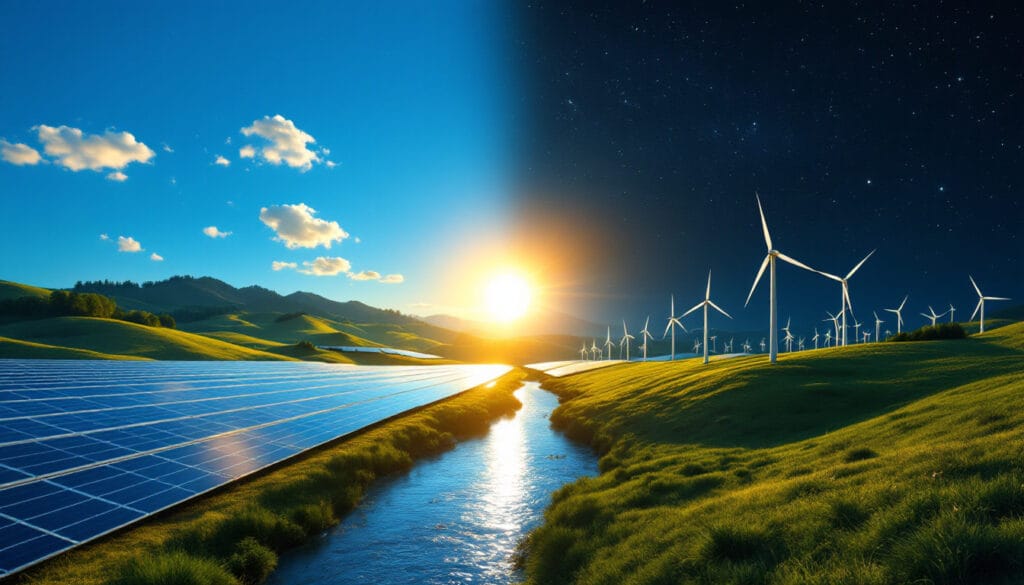Renewable energies are taking up an increasing amount of space in our energy landscape thanks to their undeniable ecological potential. However, the variations inherent to them, particularly with solar and wind energy, pose challenges. This phenomenon, commonly referred to as intermittency, raises questions about the stability of electrical supply. Exploring this notion and the solutions available allows us to understand the true assets and limits of our energy transition towards a sustainable future.
Glossary: Understanding the Intermittency of Renewable Energies
Energy Intermittency: Energy intermittency refers to the variations in electricity production associated with renewable energies such as wind and solar. These sources depend on weather conditions and do not provide constant production.
Renewable Energies: Renewable energies include various energy sources derived from repetitive natural phenomena such as the Sun, wind, or hydraulics. Unlike fossil sources, they naturally regenerate on a human scale.
Solar Energy Sources: The energy coming from the Sun, particularly captured by photovoltaic solar panels. Daily sunlight offers varying production based on the day/night cycle and weather conditions.
Wind Energy: The energy generated by the wind through wind turbines. The variable nature of wind leads to oscillating production, influenced by the dominant wind patterns in France, such as Mediterranean, Atlantic, and continental.
Variability: A term used to describe the fluctuations in energy production related to natural conditions. Unlike intermittency, it defines a smoother transition between production levels rather than a sharp cut-off.
Smart Grids: Intelligent electrical networks that integrate digital technologies to monitor, analyze, control, and communicate within the network. They enable better management of variable renewable energies, thus optimizing the distribution and consumption of energy.
Energy Storage: Energy storage solutions such as batteries (e.g., Tesla) allow for the storage of excess energy produced during peak production times for later use, thus bridging periods of low production.
Diversity: Diversity refers to the geographical dispersion of energy installations, allowing to moderate peaks and troughs in production. It relies on networking multiple production sources to smooth their variability.
Dam Hydraulics: A form of hydroelectricity where dams control water flow to produce electricity. It offers a more easily programmable renewable source, capable of compensating for the shortfalls of wind and solar energy.
Flexibility Mechanisms: Solutions that use advanced technologies to respond to fluctuations in supply by adapting to demand, including storage devices and demand response.
Interconnected Networks: Systems that allow connectivity between different electrical networks, promoting the transfer of loads from high production areas to low production areas to balance electrical supply.
Centralization and Mutualization: Strategies for energy management that involve sharing infrastructures to maximize production efficiency. Instead of considering each power plant separately, it is about thinking of the energy system as a whole.
Complementarity: Interaction of various renewable energy sources to maximize overall efficiency. For example, when solar production declines, wind or hydraulics can fill the deficit.
To explore these concepts in more depth, feel free to visit: Advantages of parabolic collectors and Renewable energies remain essential.

“`html
FAQ: Understanding the Intermittency of Renewable Energies
Frequently Asked Questions
Q: What is energy intermittency?
A: Energy intermittency refers to the irregularity of electricity production generated by renewable energies, primarily wind and solar. This variability is due to environmental factors like weather.
Q: Why does the intermittency of renewable energies pose challenges for the electrical grid?
A: Intermittency poses challenges because it can lead to unexpected fluctuations in energy supply, forcing grid managers to constantly balance supply and demand to avoid energy shortages.
Q: What solutions exist to manage the intermittency of renewable energies?
A: Several solutions include energy storage, the development of smart grids, optimizing natural resources, and improving existing infrastructures. These measures help smooth production fluctuations.
Q: How does energy storage help manage intermittency?
A: Energy storage systems, such as Tesla batteries, allow the storage of excess energy produced during periods of high production and release it during periods of low production, thus ensuring a stable energy source.
Q: What role do smart grids play in managing intermittency?
A: Smart grids integrate digital technologies that facilitate flexible and optimal management of energy distribution, improving communication between producers and consumers, and optimizing real-time energy management.
Q: Which countries have successfully implemented solutions to manage intermittency?
A: Countries like Germany and Denmark have used energy storage infrastructures and smart networks to effectively manage intermittency and integrate a significant share of renewable energies into their energy mix.
Articles similaires
Thank you!
We will contact you soon.













